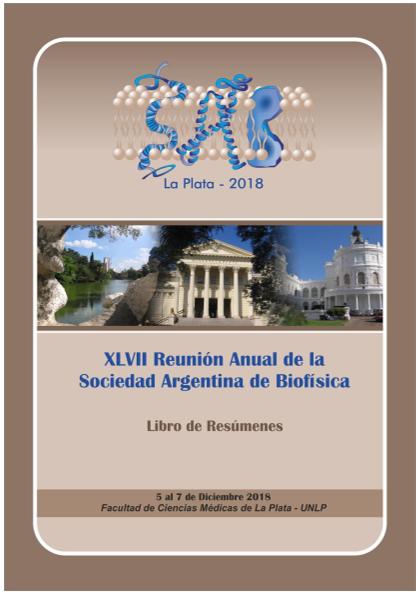Mostrar el registro sencillo del ítem
dc.contributor.author
Lasala, Matías Marcelo

dc.contributor.author
Fabiani, Camila

dc.contributor.author
Corradi, Jeremias

dc.contributor.author
Antollini, Silvia Susana

dc.contributor.author
Bouzat, Cecilia Beatriz

dc.date.available
2024-04-03T14:24:04Z
dc.date.issued
2018
dc.identifier.citation
Molecular modulation of human α7 Nicotinic Receptor by amyloid-β peptides; XLVII Reunión Anual de la Sociedad Argentina de Biofísica; La Plata; Argentina; 2018; 104-104
dc.identifier.isbn
978-987-27591-6-2
dc.identifier.uri
http://hdl.handle.net/11336/231803
dc.description.abstract
myloid β peptide (Aβ) is a key player in the development of Alzheimer disease (AD). It is the primary component of senile plaques in AD patients and is also found in soluble forms. Cholinergic activity mediated by α7 nicotinic receptors has been shown to be affected by Aβ soluble forms. To shed light into the molecular mechanism of this effect, we explored the direct actions of oligomeric Aβ1-40 and Aβ1-42 on human α7 by fluorescence spectroscopy and single-channel recordings. Fluorescence measurements using the conformational sensitive probe crystal violet (CrV), which shows different affinities for resting and desensitized states, revealed that Aβ induces α7 concentration-dependent conformational changes. At 100 pM, Aβ displaces CrV Kd value for the resting state towards that of the desensitized state from which α7 is still reactive to carbamycholine (Carb). These observations are compatible with the induction of active/desensitized states as well as of a novel conformational state in the presence of both Aβ and Carb. At 100 nM Aβ, α7 adopts a resting-state-like structure which does not respond to Carb, indicating the stabilization of α7 in a blocked state. In real time, we found that Aβ is capable of eliciting α7 channel activity either in the absence or presence of the positive allosteric modulator PNU-120596. Activation by Aβ is favored at picomolar or low nanomolar concentrations and is not detected at micromolar concentrations. At high Aβ concentrations, the durations of the activation episodes elicited by ACh are significantly reduced, an effect compatible with slow open- channel block. We conclude that Aβ directly affects α7 function and acts as an agonist and a negative modulator: activation of α7 by low Aβ concentrations may be involved in beneficial physiological effects, and the reduced α7 activity in the presence of higher Aβ concentrations may contribute to the cholinergic signaling deficit and may be involved in the initiation and development of AD
dc.format
application/pdf
dc.language.iso
eng
dc.publisher
Sociedad Argentina de Biofísica
dc.rights
info:eu-repo/semantics/openAccess
dc.rights.uri
https://creativecommons.org/licenses/by-nc-sa/2.5/ar/
dc.subject
NICOTINIC RECEPTORS
dc.subject
MODULATION
dc.subject
NEURODEGENERATION
dc.subject
AMYLOID BETA
dc.subject.classification
Biofísica

dc.subject.classification
Ciencias Biológicas

dc.subject.classification
CIENCIAS NATURALES Y EXACTAS

dc.title
Molecular modulation of human α7 Nicotinic Receptor by amyloid-β peptides
dc.type
info:eu-repo/semantics/publishedVersion
dc.type
info:eu-repo/semantics/conferenceObject
dc.type
info:ar-repo/semantics/documento de conferencia
dc.date.updated
2024-03-25T15:41:52Z
dc.journal.pagination
104-104
dc.journal.pais
Argentina

dc.journal.ciudad
Buenos Aires
dc.description.fil
Fil: Lasala, Matías Marcelo. Consejo Nacional de Investigaciones Científicas y Técnicas. Centro Científico Tecnológico Conicet - Bahía Blanca. Instituto de Investigaciones Bioquímicas de Bahía Blanca. Universidad Nacional del Sur. Instituto de Investigaciones Bioquímicas de Bahía Blanca; Argentina
dc.description.fil
Fil: Fabiani, Camila. Consejo Nacional de Investigaciones Científicas y Técnicas. Centro Científico Tecnológico Conicet - Bahía Blanca. Instituto de Investigaciones Bioquímicas de Bahía Blanca. Universidad Nacional del Sur. Instituto de Investigaciones Bioquímicas de Bahía Blanca; Argentina
dc.description.fil
Fil: Corradi, Jeremias. Consejo Nacional de Investigaciones Científicas y Técnicas. Centro Científico Tecnológico Conicet - Bahía Blanca. Instituto de Investigaciones Bioquímicas de Bahía Blanca. Universidad Nacional del Sur. Instituto de Investigaciones Bioquímicas de Bahía Blanca; Argentina
dc.description.fil
Fil: Antollini, Silvia Susana. Consejo Nacional de Investigaciones Científicas y Técnicas. Centro Científico Tecnológico Conicet - Bahía Blanca. Instituto de Investigaciones Bioquímicas de Bahía Blanca. Universidad Nacional del Sur. Instituto de Investigaciones Bioquímicas de Bahía Blanca; Argentina
dc.description.fil
Fil: Bouzat, Cecilia Beatriz. Consejo Nacional de Investigaciones Científicas y Técnicas. Centro Científico Tecnológico Conicet - Bahía Blanca. Instituto de Investigaciones Bioquímicas de Bahía Blanca. Universidad Nacional del Sur. Instituto de Investigaciones Bioquímicas de Bahía Blanca; Argentina
dc.conicet.rol
Autor

dc.conicet.rol
Autor

dc.conicet.rol
Autor

dc.conicet.rol
Autor

dc.conicet.rol
Autor

dc.coverage
Internacional
dc.type.subtype
Congreso
dc.description.nombreEvento
XLVII Reunión Anual de la Sociedad Argentina de Biofísica
dc.date.evento
2018-12-05
dc.description.ciudadEvento
La Plata
dc.description.paisEvento
Argentina

dc.type.publicacion
Book
dc.description.institucionOrganizadora
Sociedad Argentina de Biofísica
dc.source.libro
XLVII Reunión Anual de la Sociedad Argentina de Biofísica
dc.date.eventoHasta
2018-12-07
dc.type
Congreso
Archivos asociados
